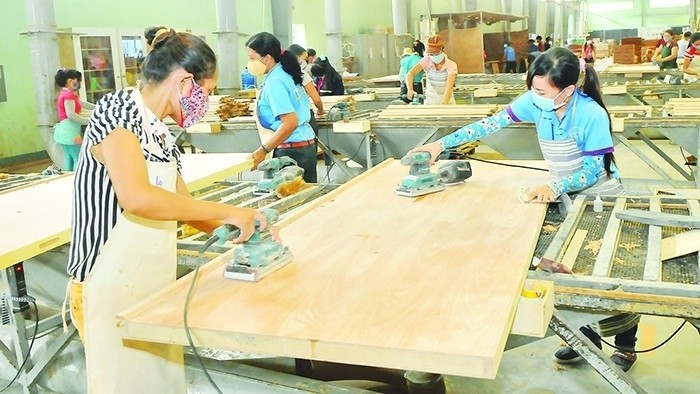High export growth thanks to FTAs
The Wood industry is valued as one of the industries benefiting the most from the EU-Vietnam FTA. Chairman of Saigon Trade and Production Development Corporation (SADACO) Tran Quoc Manh said that EVFTA brings about several benefits for the export of Vietnamese wood to the EU including the reduction and removal of tariffs as scheduled.
The EVFTA will also create opportunities for Vietnamese enterprises to approach EU modern machinery and distribution channels. In addition, compulsory requirements and high standards of the FTA will urge enterprises to enhance their own business management capacity and improve their products and production processes.
SADACO is one of enterprises that have taken advantage of incentives from signed FTAs. Manh said that with over 30-year experience in wood production, the company is self-confident in implementing FTAs, noting that the company has grasped fully related information and the implementation of the EVFTA. The wood export revenue to the EU accounted for nearly 40% of SADACO’s total revenue of VND500 billion (US$21.5 million) in the past year, Manh added.
Statistics from the Ministry of Industry and Trade (MoIT) show that Vietnam has recorded good export growth with markets that Vietnam has signed FTAs with and Vietnam has also taken advantage of incentives from FTAs.
Specifically, Vietnam reported US$13.39 billion worth of export revenue to Japan in the first eight months of this year, a year-on-year increase of 9.9% and US$12.56 billion worth of export revenue to the Republic of Korea, a year-on-year increase of 5.3%.
Vietnam also posted an export revenue of US$17.3 billion to ASEAN (up 3.7%), US$1.92 billion to Russia (up 14.2%), US$358.8 million to New Zealand (up 12.8% over the same period last year), among others.
In particular, Vietnam’s export revenue to member states of the Comprehensive and Progressive Agreement for Trans-Pacific Partnership (CPTPP) also saw positive growth. Vietnam gained an export revenue of US$2.59 billion to Canada in the first eight months of this year, a year-on-year increase of 31.3% and reported US$1.85 billion worth of export revenue to Mexico, a year-on-year increase of 20.9%. Canada is currently the market with the strongest export growth rate with Vietnam which has increased by 2.3 times compared to the same period in 2018.
Economist Pham Tat Thang, former Director of the Vietnam Industry and Trade Information Centre under the MoIT said that CPTPP and EVFTA are considered the most important agreements to Vietnam which have opened up conditions for Vietnamese goods to enter high-end markets.
CPTPP is valued as a new generation FTA with high-level commitments. Many Vietnamese products can be effectively exported to these markets such as textiles, footwear, phones, seafood, and others.
CPTPP and EVFTA are also expected to boost imports to Vietnam including the import of modern technology at reasonable prices to increase the economic capacity in the future, Thang noted.
Great importance should be attached to origin of goods
Thang expressed his belief that import and export of goods will maintain at a good pace in the remaining months of the year, especially when FTAs are increasingly effective. Many investment projects in the clean agriculture sector have begun to be operational, creating abundant sources of goods to be exported. If the EU removes the yellow card for Vietnamese seafood by the year’s end, the exports of seafood in particular and goods in general to this market will certainly thrive, Thang said.
However, a number of traditional goods have seen a decline in export turnover such as rice, coal, oil and others, requiring more efforts from domestic exporters.
In addition, EVFTA and CPTPP help Vietnam to have more tax incentives in some large and potential markets such as Canada, Mexico, Peru, France, and Germany that enterprises should pay special attention to.
“But it must be noted that only when Vietnamese goods have a certificate of Vietnamese origin with a certain localisation rate that can they enjoy tax incentives. Therefore, enterprises should try to localise their products while preventing foreign goods from impersonating Vietnamese goods for being exported to CPTPP countries, ” Thang emphasised.
Sharing the same opinion with Thang, Manh said that EVFTA poses a big challenge for the wood industry because the EU has set up a considerable technical barrier which is to identify the origin of wood materials put into production. Meanwhile, the Vietnamese wood industry still has to use nearly 50% of imported materials, causing difficulties for enterprises to determine the origin of wood materials imported into Vietnam and also the origin of wood raw materials produced in Vietnam.
“In the immediate future, the EU has recognised the difficulties of Vietnamese enterprises so it is supporting enterprises under the Handicraft and Wood Industry Association of Ho Chi Minh City to implement a project to identify origin in a sustainable manner. Although this project is not large, it shows the positiveness of the EU and also benefits a number of enterprises” Manh said.
Although non-tariff barriers are removed, technical barriers increase under the effectiveness of CPTPP and EVFTA that make Vietnam no longer benefit from cheap labour, but improved quality. This also urges Vietnam to implement more seriously the Government's policy of economic restructuring and instructional reform to bring more benefits to producers.
Enterprises also need to make more efforts to gain initiative in raw materials in order to further expand their markets, not only among countries signing FTAs with Vietnam.
















